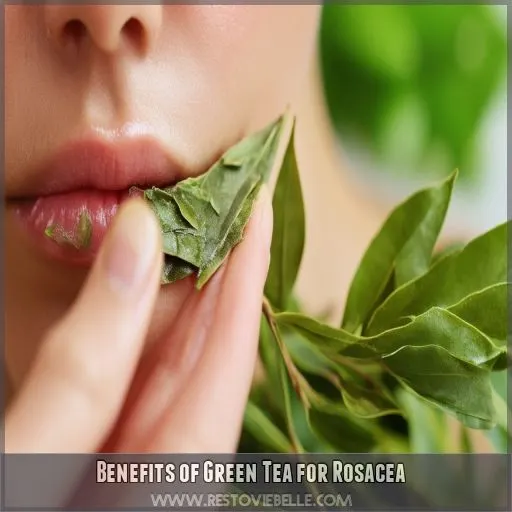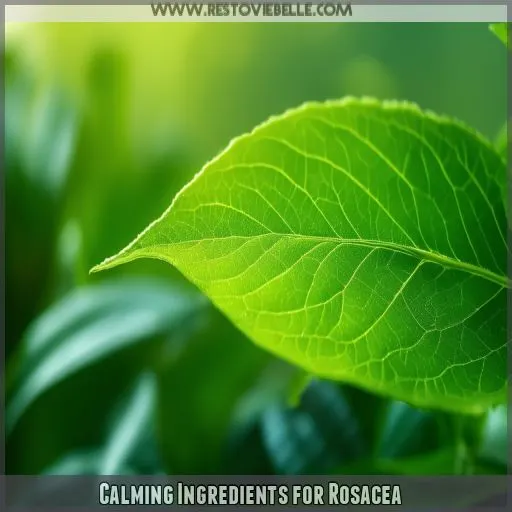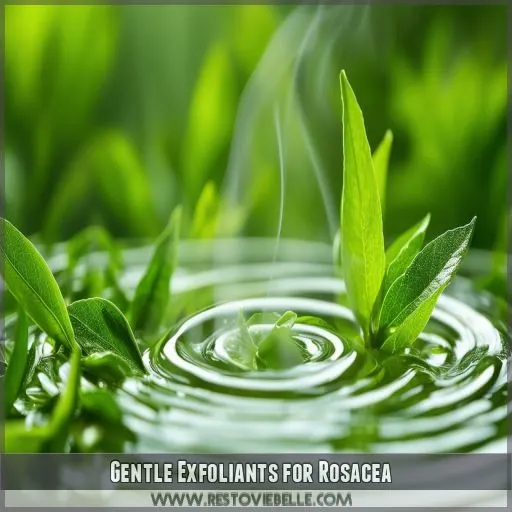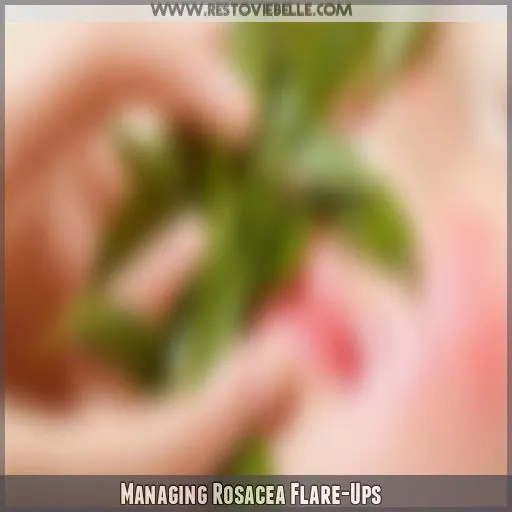This site is supported by our readers. We may earn a commission, at no cost to you, if you purchase through links.
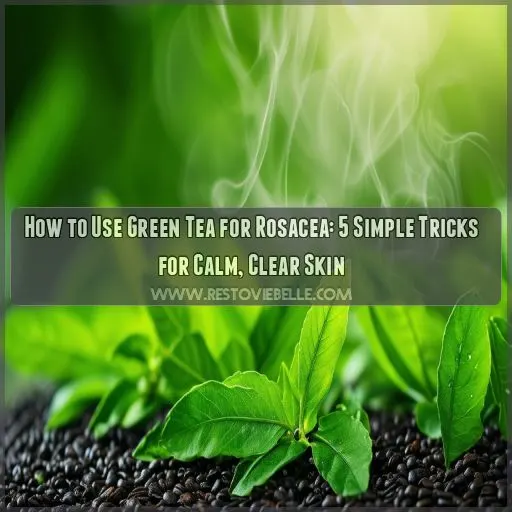
Green tea, with its antioxidants, anti-inflammatory properties, and UV protection, may be your skin’s new best friend.
You can use it both internally and topically for clearer skin.
This article will show you how to incorporate green tea into your routine and share other calming ingredients and gentle exfoliants to help manage your rosacea.
Table Of Contents
- Key Takeaways
- Benefits of Green Tea for Rosacea
- How to Use Green Tea for Rosacea
- Calming Ingredients for Rosacea
- Gentle Exfoliants for Rosacea
- Managing Rosacea Flare-Ups
- Frequently Asked Questions (FAQs)
- Does green tea help rosacea?
- How to cure rosacea?
- Can tea tree oil help rosacea?
- Does drinking tea cause rosacea?
- How do you apply green tea directly to your face?
- Is green tea serum good for rosacea?
- Is green tea cleanser good for rosacea?
- How do you calm down rosacea fast?
- What are the side effects of green tea?
- Is green tea better than medication?
- How does green tea compare to other natural treatments?
- Is green tea safe to use with other treatments?
- How quickly does green tea work?
- Conclusion
Key Takeaways
- Green tea is a skin savior for rosacea sufferers, packed with antioxidants and anti-inflammatory properties that reduce redness and irritation. Sip it or apply it directly for clearer skin.
- It also provides UV protection, shielding your skin from sun damage, a common trigger for rosacea flare-ups.
- Topical application of green tea is easy and effective. Brew a cup and use it as a cold compress, mix the powder with olive oil for a DIY mask, or look for skincare products with green tea extract.
- Pair green tea treatments with lifestyle changes, such as avoiding trigger foods, protecting your skin from the sun, and staying hydrated, for the best results.
Benefits of Green Tea for Rosacea
Green tea offers numerous benefits for rosacea sufferers, including powerful antioxidant and anti-inflammatory properties that can reduce redness and irritation. It also provides UV protection, improves skin texture, and has shown promising results in clinical studies, making it a valuable addition to your rosacea management routine.
Ioxidant Properties
You’ve probably heard about green tea‘s health benefits, but did you know it’s a powerhouse for your skin?
Packed with antioxidants, this natural remedy can work wonders for rosacea.
These skin-loving compounds help fortify your skin barrier, protecting it from environmental stressors.
Anti-inflammatory and Anticarcinogen Properties
Green tea’s anti-inflammatory and anticarcinogen properties pack a one-two punch against rosacea flare-ups.
Research shows that these powerful compounds can calm angry, red skin and potentially prevent long-term damage.
By sipping on or applying green tea regularly, you’re not just soothing your skin – you’re also giving it a fighting chance against future flare-ups.
It’s like having a tiny army of skin defenders at your disposal!
UV Protection
You’ll be glad to know that green tea can shield your skin from harmful UV rays, a common trigger for rosacea flare-ups. This natural sun protection helps minimize stress on your skin, keeping it calm and clear. Here’s how green tea acts as your skin’s bodyguard:
- Absorbs UV radiation
- Neutralizes free radicals caused by sun damage
- Enhances your skin’s natural defense mechanisms
Skin Texture Improvement
Green tea doesn’t just shield your skin from UV rays; it’s also your secret weapon for smoother, clearer skin.
When applied topically, it can help reduce that bumpy texture often associated with rosacea.
You’ll notice your skin’s complexion improving as inflammation subsides.
For an extra boost, try mixing green tea powder with oatmeal or rice flour to create a gentle, texture-improving mask.
Your skin will thank you!
Clinical Evidence
You’ll be pleased to know that green tea‘s benefits for rosacea aren’t just anecdotal.
Scientific evidence backs it up!
A groundbreaking study on women with rosacea showed a whopping 70% improvement compared to a placebo.
This clinical trial‘s findings are music to your ears if you’re battling those pesky red patches.
Green tea, along with other natural remedies like chamomile, is proving to be a powerful ally in the fight against rosacea.
How to Use Green Tea for Rosacea
Green tea offers multiple ways to soothe your rosacea-prone skin, both internally and externally. You can drink green tea for its overall health benefits or apply it topically through compresses, masks, and skincare products to directly target affected areas.
Internal Consumption
Incorporating green tea into your daily routine can be a game-changer for your skin health.
Start your morning ritual with a steaming cup of this antioxidant-rich brew.
It’s not just a treat for your taste buds; it’s a powerhouse of benefits for your gut health too.
Pair it with prebiotic foods and omega-3s, while steering clear of trigger foods.
Your skin will thank you for this simple yet effective change.
Topical Application
You’ll love how easy it’s to apply green tea topically for rosacea relief. Here are four simple ways to harness its skin-soothing power:
- Brew a cup of green tea and let it cool for a soothing cold compress
- Mix green tea powder with olive oil for a nourishing DIY mask
- Look for skincare products containing green tea extract
- Create a soothing blend with green tea, tea tree oil, and lavender essential oil
These methods deliver green tea’s benefits directly to your skin, helping calm inflammation and reduce redness.
Green Tea Facial Recipes
Ready to harness green tea‘s power for your rosacea? Try these DIY recipes.
Mix green tea powder with olive oil for a soothing mask, or blend it with rice flour and lemon juice for oily skin.
For a hydrating treat, combine green tea water with raw honey.
Looking for convenience? Seek out green tea-infused creams.
These natural remedies offer skin benefits and may help calm your rosacea symptoms.
Tips for Using Green Tea for Rosacea
Now that you’ve got your green tea recipes ready, let’s take a closer look at some tips to maximize their effectiveness for your rosacea.
Pair your green tea treatments with lifestyle changes like avoiding trigger foods and protecting your skin from the sun.
Don’t forget to stay hydrated and consult your dermatologist if symptoms persist.
Green tea can be a powerful ally in your beauty regimen, offering calming effects and a natural remedy for rosacea.
Internal Vs. Topical Application
You’ve got options when it comes to using green tea for rosacea: drink it or apply it directly.
Both methods have their perks.
Sipping green tea with a splash of lemon can boost your overall health, while topical application targets skin directly.
For the best results, why not try both?
Brew a cup to enjoy and save some for a soothing face mask with honey or olive oil.
Calming Ingredients for Rosacea
In addition to green tea, several other calming ingredients can help manage rosacea symptoms. Chamomile, niacinamide (vitamin B3), azelaic acid, and licorice root extract are known for their anti-inflammatory properties and can be effective in soothing redness and irritation associated with rosacea.
Chamomile
While green tea‘s a powerhouse for rosacea, don’t overlook chamomile‘s soothing prowess.
This gentle giant packs a punch against inflammation, much like its green cousin.
Brew a cup of chamomile tea, let it cool, and apply it to your skin for instant relief.
You can even mix it with green tea for a double dose of calm.
It’s nature’s way of saying, "Relax, we’ve got this!
Niacinamide (Vitamin B3)
You’ve probably heard of niacinamide, but did you know it’s a game-changer for rosacea?
This versatile vitamin B3 powerhouse tackles inflammation head-on, calming your skin’s angry outbursts.
It’s like a soothing balm for your complexion, reducing redness and irritation.
But that’s not all – niacinamide also strengthens your skin barrier, keeping moisture in and irritants out.
Look for serums or moisturizers with 2-5% niacinamide for best results.
Green Tea
Green tea isn’t just for sipping; it’s a powerhouse for rosacea relief.
Packed with polyphenols, this natural remedy can help tame facial redness, bumps, and pustules.
You’ll love how it soothes your skin while fighting inflammation.
Try a green tea mask for instant relief or sip it daily for long-term benefits.
It’s like giving your skin a calming hug, minus the awkward personal space invasion!
Azelaic Acid
While green tea offers soothing benefits, azelaic acid is another powerful ally in your rosacea treatment arsenal. This naturally-occurring compound works wonders for calming skin irritation and reducing redness. Here’s why you should consider adding it to your routine:
- Fights inflammation
- Unclogs pores
- Evens skin tone
Apply azelaic acid topically for best results. It’s gentle yet effective, making it an ideal choice for sensitive skin prone to flare-ups. Remember, consistency is key when using any rosacea treatment.
Licorice Root Extract
Licorice root extract is another calming ingredient that can effectively soothe your rosacea symptoms. The flavonoids present in licorice root extract have potent anti-inflammatory effects, making it an excellent choice for reducing the redness and irritation associated with rosacea.
| Ingredient | Benefits |
|---|---|
| Licorice Root Extract | Potent anti-inflammatory effects, reducing redness and irritation |
| Azelaic Acid | Calms inflammation caused by rosacea or acne |
| Chamomile | Soothes redness and irritation with its anti-inflammatory properties |
| Niacinamide (Vitamin B3) | Helps with anti-aging, pigmentation, and inflammation |
Gentle Exfoliants for Rosacea
Gentle exfoliants are an important part of managing rosacea, helping to remove dead skin cells and unclog pores without causing irritation. Here are some gentle exfoliating ingredients and methods that are suitable for rosacea-prone skin.
Hyaluronic Acid
Hyaluronic acid is a powerful tool in your skincare arsenal, especially when dealing with rosacea.
This hydrating ingredient acts as a moisture magnet, attracting and binding water to your skin.
By creating a protective barrier, it locks in moisture, keeping your skin plump and hydrated.
Hyaluronic acid is a gentle yet effective way to improve skin health, enhance moisture retention, and promote a youthful appearance.
It’s a must-have for anyone looking to calm rosacea symptoms and achieve clear, glowing skin.
Feverfew (Processed)
Feverfew, a flowering plant, can be beneficial for rosacea. But, you want to make sure the feverfew has been processed to remove parthenolide, a common allergen. Here are some key points to keep in mind about feverfew:
- Benefits for Rosacea: Feverfew might help manage rosacea symptoms.
- Allergy Concern: Parthenolide, a natural compound in feverfew, is a known allergen.
- Processing for Safety: To be safe for rosacea-prone skin, feverfew needs to be processed to remove parthenolide.
- Exfoliating Properties: Feverfew, when processed correctly, can act as a gentle exfoliant, helping to remove dead skin cells and improve skin texture.
Zinc or Titanium Dioxide
Zinc and titanium dioxide are minerals that provide a physical barrier of protection for your skin. They’re found in physical blocker sunscreens and help protect against sun exposure, a major trigger for rosacea.
Zinc oxide and titanium dioxide are gentle on the skin and create a protective barrier that sits on top of your skin, deflecting the sun’s rays. They’re an important part of your skincare arsenal, as they help to prevent flare-ups caused by sun exposure.
Gentle Chemical Exfoliants
Gentle exfoliation is key for managing rosacea. While it’s important to avoid harsh physical exfoliants, you can still use gentle chemical exfoliants in your routine.
Here are three things to keep in mind:
- Look for products with low concentrations of specific chemical exfoliants like lactic acid or glycolic acid. These help to gently remove dead skin cells without irritating your skin.
- Focus on maintaining a healthy skin barrier. Hyaluronic acid is a great ingredient to look for as it hydrates and protects the skin without causing irritation.
- Be mindful of irritation risks. While gentle chemical exfoliants can be beneficial, it’s important to introduce them gradually and monitor your skin’s response.
Avoid Physical Exfoliators
While gentle chemical exfoliants can be beneficial, it’s important to avoid physical exfoliators when dealing with rosacea. Scrubs and physical exfoliants can be too harsh for your sensitive skin. The key is to be gentle and avoid anything that can irritate your skin further.
Managing Rosacea Flare-Ups
Rosacea flare-ups can be frustrating, but you can take control by identifying and avoiding your triggers. This might include spicy foods, alcohol, or sun exposure. Keep a journal to help you identify these triggers and manage your symptoms.
Identify Your Triggers
Rosacea flare-ups can be triggered by various factors, and figuring out these triggers is key for managing the condition. Here are some common triggers to be aware of:
- Foods: Certain foods and beverages can trigger rosacea symptoms. Keep a food diary to identify specific triggers.
- Stress: Emotional stress is a common trigger. Manage it with meditation, deep breathing, or yoga.
- Weather: Extreme temperatures, wind, and sun exposure can cause flare-ups. Protect your skin and use sunscreen.
Use Gentle Skincare
Now that you’ve identified your triggers, it’s time to adopt a gentle skincare routine.
Keep it simple and stick to calming ingredients like chamomile, niacinamide, and green tea.
Avoid harsh products, especially those with fragrances and essential oils, as these can irritate your skin.
Opt for products formulated for sensitive skin and be mindful of over-exfoliating.
A gentle, hydrating cleanser and moisturizer are key.
Your skin will thank you for it!
Protect Your Skin From the Sun
Sun protection is really important for managing rosacea. Here are some tips to protect your skin from the sun’s harmful rays:
- Wear sunscreen daily
- Look for specific ingredients
- Cover up
- Avoid peak hours
- Create a sun-safe routine
Consult a Dermatologist
If rosacea is affecting your quality of life, it’s time to consult a dermatologist for expert advice and personalized treatment options. They can help you manage your skin condition and recommend specific medications or procedures.
| Managing Rosacea | Expert Recommendations |
|---|---|
| Flare-ups | Consult a dermatologist for personalized treatment plans |
| Skin irritation | Get professional help to identify triggers and suitable skincare routines |
| Long-term management | Work with a dermatologist to find a skincare routine and treatment plan that suits your skin |
Stay Hydrated
Drinking water is really important for maintaining healthy skin, especially when managing rosacea flare-ups. Water helps keep your skin hydrated, which is essential for overall skin health. Aim to drink plenty of water throughout the day to support your skin’s hydration and promote a clear, healthy complexion.
Frequently Asked Questions (FAQs)
Does green tea help rosacea?
Yes, green tea helps with rosacea. It has anti-inflammatory, antioxidant, and antibacterial properties. Drink it during flare-ups or apply topically to irritated skin.
How to cure rosacea?
Although there’s no cure for rosacea, you can manage symptoms by identifying and avoiding triggers, adopting a gentle skincare routine, and seeking medical treatments.
Can tea tree oil help rosacea?
Tea tree oil can help with rosacea as it has antimicrobial and anti-inflammatory properties. It can kill Demodex mites, which are often found in high numbers on those with rosacea.
Does drinking tea cause rosacea?
Drinking tea, especially hot tea, and drinking tea frequently, has been associated with an increased risk of rosacea.
How do you apply green tea directly to your face?
brew a cup of green tea, let it cool, then use a cotton pad to apply it to your face. You can also cut open the tea bag, mix the leaves with honey, and apply the paste to your face for 15 minutes. Alternatively, mix green tea powder with organic honey, castile soap, and tea tree oil for a cleanser.
Is green tea serum good for rosacea?
Yes, green tea serum is good for rosacea. Green tea is an antioxidant and anti-inflammatory, and it has UV-protective effects, making it a safe choice for topical rosacea treatment.
Is green tea cleanser good for rosacea?
Yes, green tea is a good choice for treating rosacea. It has antioxidant, anti-inflammatory, and UV-protective effects, which can help reduce inflammation and redness. Topical application is recommended, and you can add green tea extract to a cleanser.
How do you calm down rosacea fast?
To calm rosacea flare-ups, use a gentle, fragrance-free moisturiser and keep the affected skin cool. Avoid triggers like spicy foods, alcohol, and dry air. Soothe skin with aloe vera, oatmeal, lavender, or chamomile.
What are the side effects of green tea?
Green tea can cause dizziness and, in rare cases, convulsions or confusion. It may also cause digestive issues, including constipation, acid reflux, nausea, and diarrhea. If you’re new to green tea, start with 1-2 cups per day and monitor your reaction.
Is green tea better than medication?
Green tea is a natural, safe choice for treating rosacea. However, there’s no clear evidence that it’s better than medication. Rosacea treatments must be adjusted by a physician to each individual case.
How does green tea compare to other natural treatments?
Research shows that green tea is an effective natural treatment for rosacea, with 70% of women experiencing improvements. It compares well to other natural treatments like lavender oil and oatmeal masks.
Is green tea safe to use with other treatments?
Yes, green tea is safe to use with other treatments for rosacea. However, tea can be a trigger for rosacea, so it’s recommended to drink tea in moderation.
How quickly does green tea work?
Results vary, but one source suggests that you should see improvements within a week. Another says you should notice a decrease in redness over a couple of days.
Conclusion
Is your skin in need of some serious TLC?
Green tea is a powerhouse ingredient that can help calm and clear your complexion. You now know how to harness its benefits both internally and topically.
From incorporating calming ingredients like chamomile and niacinamide to gentle exfoliants like hyaluronic acid, you’re well on your way to managing your rosacea with confidence.
Remember to identify your triggers, practice gentle skincare, protect your skin from the sun, stay hydrated, and consult a dermatologist if needed.
By following these simple tricks, you’ll be well on your way to achieving calm, clear skin and giving your skin the TLC it deserves.

